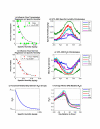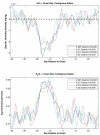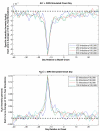Absolute Humidity and the Seasonal Onset of Influenza in the Continental US
- PMID: 20066155
- PMCID: PMC2803311
- DOI: 10.1371/currents.RRN1138
Absolute Humidity and the Seasonal Onset of Influenza in the Continental US
Abstract
Much of the observed wintertime increase of mortality in temperate regions is attributed to seasonal influenza. A recent re-analysis of laboratory experiments indicates that absolute humidity strongly modulates the airborne survival and transmission of the influenza virus. Here we extend these findings to the human population level, showing that the onset of increased wintertime influenza-related mortality in the United States is associated with anomalously low absolute humidity levels during the prior weeks. We then use an epidemiological model, in which observed absolute humidity conditions temper influenza transmission rates, to successfully simulate the seasonal cycle of observed influenza-related mortality. The model results indicate that direct modulation of influenza transmissibility by absolute humidity alone is sufficient to produce this observed seasonality. These findings provide epidemiological support for the hypothesis that absolute humidity drives seasonal variations of influenza transmission in temperate regions.
References
-
- Reichert TA, et al. (2004) Influenza and the winter increase in mortality in the United States, 1959-1999. Am J Epidemiology 160: 492-502. - PubMed
-
- Smith DJ, et al. (2004) Mapping the antigenic and genetic evolution of influenza virus. Science 305: 371-376. - PubMed
-
- Simonsen L, et al. (2005) Impact of influenza vaccination on seasonal mortality in the US elderly population. Arch Intern Med 165: 265-272. - PubMed
-
- Viboud C, et al. (2006) Synchrony, waves, and spatial hierarchies in the spread of influenza. Science 312: 447-451. - PubMed
-
- Centers for Disease Control and Prevention (2009). Influenza. www.cdc.gov/flu/.
LinkOut - more resources
Full Text Sources





